Analyzing Leadership and Management Styles in Organizations
VerifiedAdded on 2023/06/15
|10
|2632
|155
Report
AI Summary
This report provides a comprehensive analysis of leadership and management styles, focusing on Marks and Spencer as a primary example. It defines the roles of leaders and managers, differentiating between hard and soft skills required for each. The report explores the application of transformati...
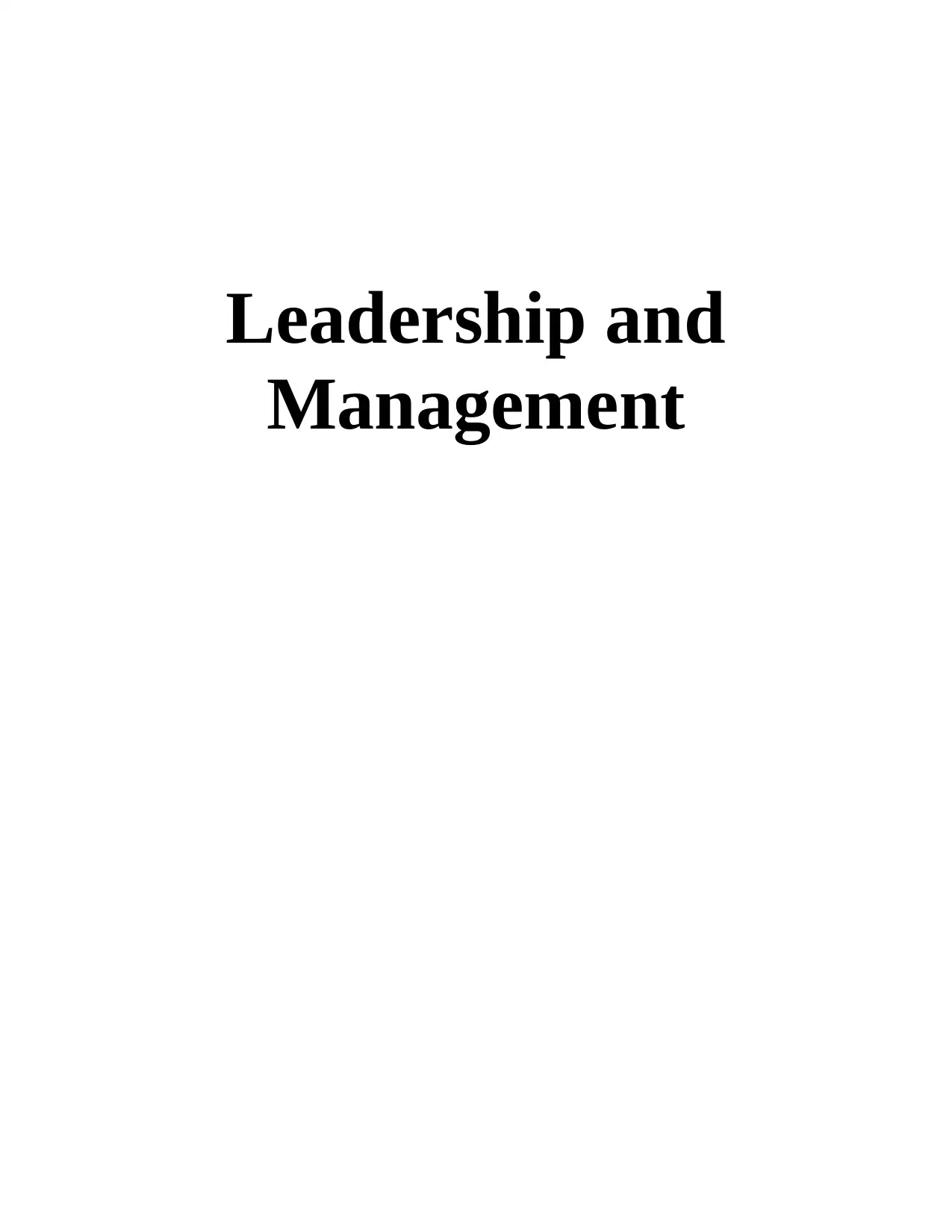
Leadership and
Management
Management
Paraphrase This Document
Need a fresh take? Get an instant paraphrase of this document with our AI Paraphraser
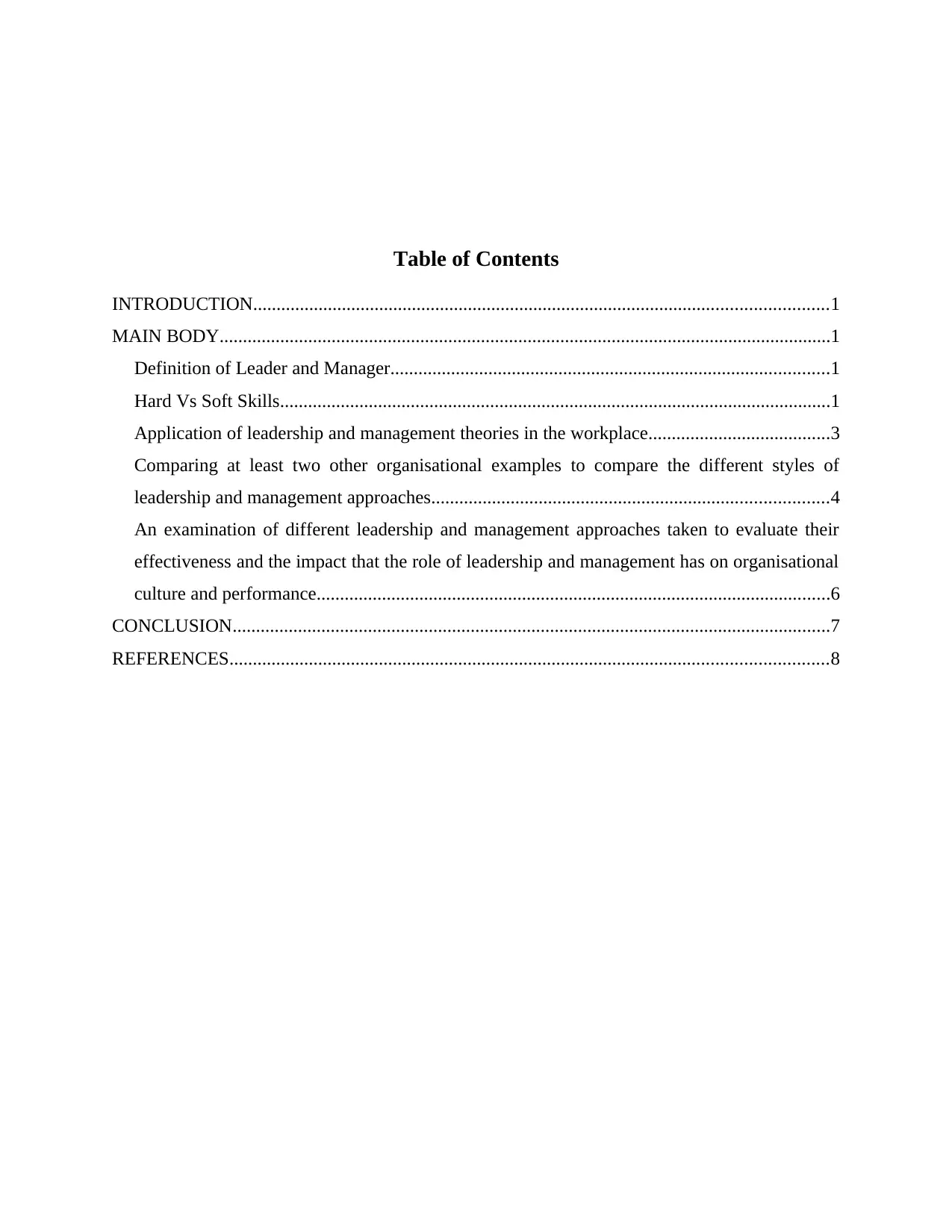
Table of Contents
INTRODUCTION...........................................................................................................................1
MAIN BODY...................................................................................................................................1
Definition of Leader and Manager..............................................................................................1
Hard Vs Soft Skills......................................................................................................................1
Application of leadership and management theories in the workplace.......................................3
Comparing at least two other organisational examples to compare the different styles of
leadership and management approaches.....................................................................................4
An examination of different leadership and management approaches taken to evaluate their
effectiveness and the impact that the role of leadership and management has on organisational
culture and performance..............................................................................................................6
CONCLUSION................................................................................................................................7
REFERENCES................................................................................................................................8
INTRODUCTION...........................................................................................................................1
MAIN BODY...................................................................................................................................1
Definition of Leader and Manager..............................................................................................1
Hard Vs Soft Skills......................................................................................................................1
Application of leadership and management theories in the workplace.......................................3
Comparing at least two other organisational examples to compare the different styles of
leadership and management approaches.....................................................................................4
An examination of different leadership and management approaches taken to evaluate their
effectiveness and the impact that the role of leadership and management has on organisational
culture and performance..............................................................................................................6
CONCLUSION................................................................................................................................7
REFERENCES................................................................................................................................8
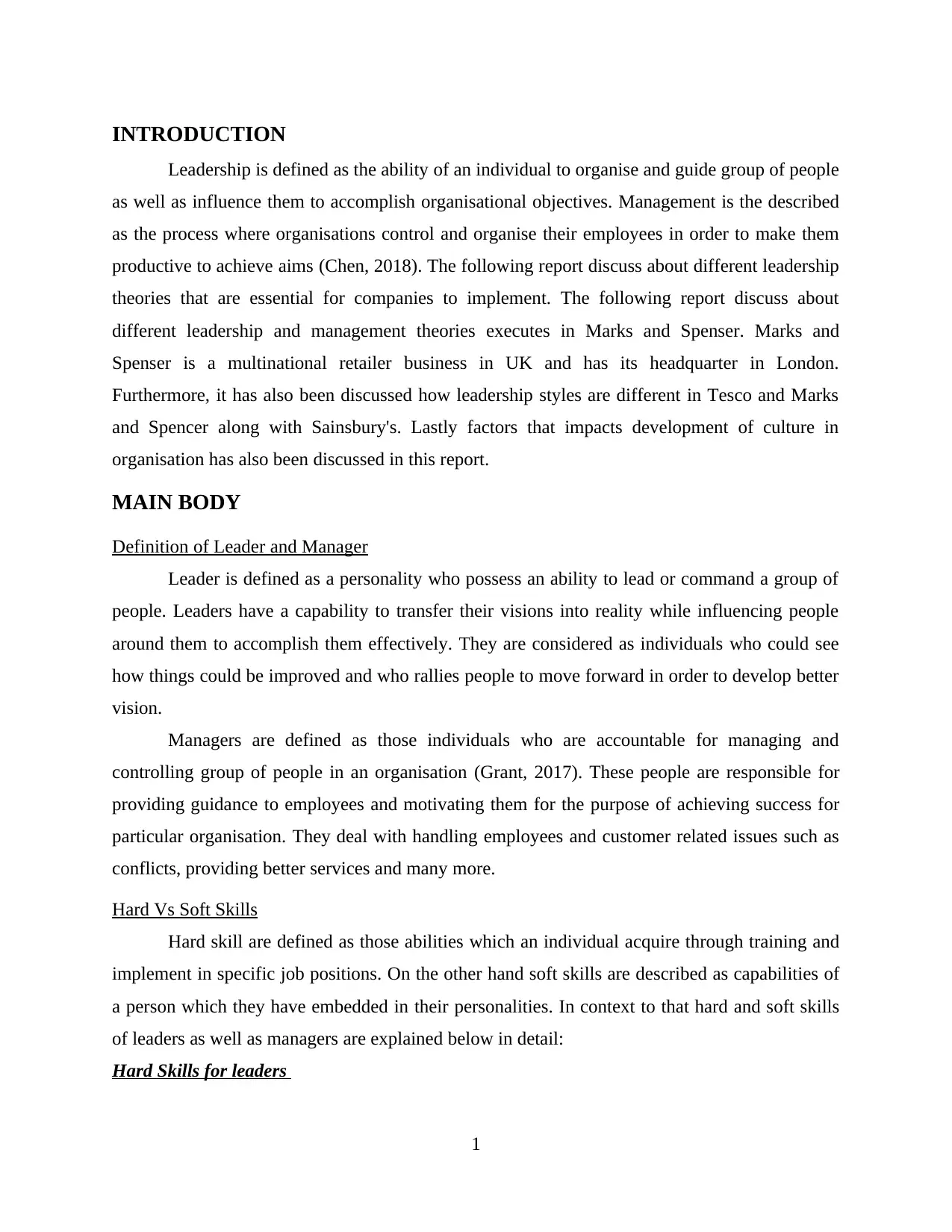
INTRODUCTION
Leadership is defined as the ability of an individual to organise and guide group of people
as well as influence them to accomplish organisational objectives. Management is the described
as the process where organisations control and organise their employees in order to make them
productive to achieve aims (Chen, 2018). The following report discuss about different leadership
theories that are essential for companies to implement. The following report discuss about
different leadership and management theories executes in Marks and Spenser. Marks and
Spenser is a multinational retailer business in UK and has its headquarter in London.
Furthermore, it has also been discussed how leadership styles are different in Tesco and Marks
and Spencer along with Sainsbury's. Lastly factors that impacts development of culture in
organisation has also been discussed in this report.
MAIN BODY
Definition of Leader and Manager
Leader is defined as a personality who possess an ability to lead or command a group of
people. Leaders have a capability to transfer their visions into reality while influencing people
around them to accomplish them effectively. They are considered as individuals who could see
how things could be improved and who rallies people to move forward in order to develop better
vision.
Managers are defined as those individuals who are accountable for managing and
controlling group of people in an organisation (Grant, 2017). These people are responsible for
providing guidance to employees and motivating them for the purpose of achieving success for
particular organisation. They deal with handling employees and customer related issues such as
conflicts, providing better services and many more.
Hard Vs Soft Skills
Hard skill are defined as those abilities which an individual acquire through training and
implement in specific job positions. On the other hand soft skills are described as capabilities of
a person which they have embedded in their personalities. In context to that hard and soft skills
of leaders as well as managers are explained below in detail:
Hard Skills for leaders
1
Leadership is defined as the ability of an individual to organise and guide group of people
as well as influence them to accomplish organisational objectives. Management is the described
as the process where organisations control and organise their employees in order to make them
productive to achieve aims (Chen, 2018). The following report discuss about different leadership
theories that are essential for companies to implement. The following report discuss about
different leadership and management theories executes in Marks and Spenser. Marks and
Spenser is a multinational retailer business in UK and has its headquarter in London.
Furthermore, it has also been discussed how leadership styles are different in Tesco and Marks
and Spencer along with Sainsbury's. Lastly factors that impacts development of culture in
organisation has also been discussed in this report.
MAIN BODY
Definition of Leader and Manager
Leader is defined as a personality who possess an ability to lead or command a group of
people. Leaders have a capability to transfer their visions into reality while influencing people
around them to accomplish them effectively. They are considered as individuals who could see
how things could be improved and who rallies people to move forward in order to develop better
vision.
Managers are defined as those individuals who are accountable for managing and
controlling group of people in an organisation (Grant, 2017). These people are responsible for
providing guidance to employees and motivating them for the purpose of achieving success for
particular organisation. They deal with handling employees and customer related issues such as
conflicts, providing better services and many more.
Hard Vs Soft Skills
Hard skill are defined as those abilities which an individual acquire through training and
implement in specific job positions. On the other hand soft skills are described as capabilities of
a person which they have embedded in their personalities. In context to that hard and soft skills
of leaders as well as managers are explained below in detail:
Hard Skills for leaders
1
You're viewing a preview
Unlock full access by subscribing today!
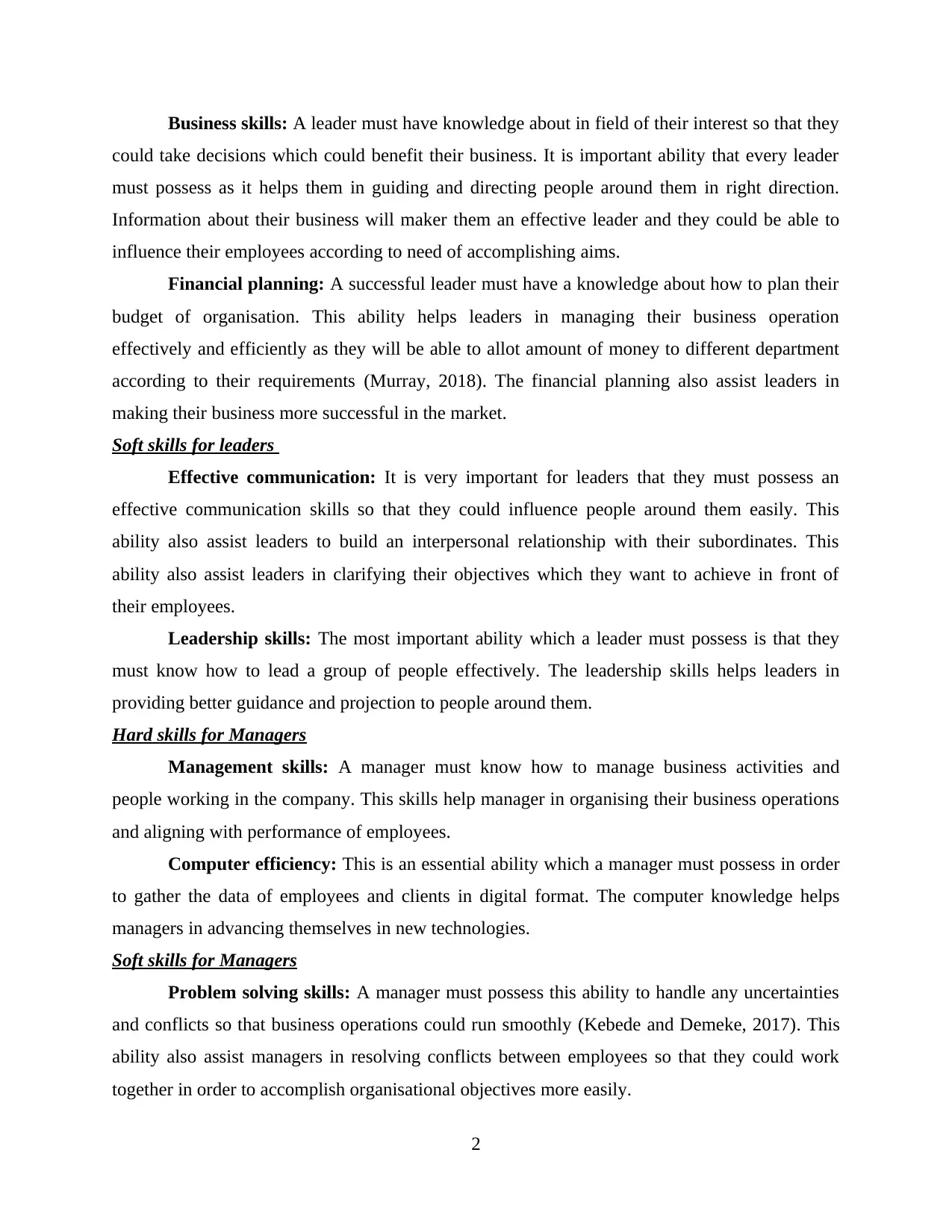
Business skills: A leader must have knowledge about in field of their interest so that they
could take decisions which could benefit their business. It is important ability that every leader
must possess as it helps them in guiding and directing people around them in right direction.
Information about their business will maker them an effective leader and they could be able to
influence their employees according to need of accomplishing aims.
Financial planning: A successful leader must have a knowledge about how to plan their
budget of organisation. This ability helps leaders in managing their business operation
effectively and efficiently as they will be able to allot amount of money to different department
according to their requirements (Murray, 2018). The financial planning also assist leaders in
making their business more successful in the market.
Soft skills for leaders
Effective communication: It is very important for leaders that they must possess an
effective communication skills so that they could influence people around them easily. This
ability also assist leaders to build an interpersonal relationship with their subordinates. This
ability also assist leaders in clarifying their objectives which they want to achieve in front of
their employees.
Leadership skills: The most important ability which a leader must possess is that they
must know how to lead a group of people effectively. The leadership skills helps leaders in
providing better guidance and projection to people around them.
Hard skills for Managers
Management skills: A manager must know how to manage business activities and
people working in the company. This skills help manager in organising their business operations
and aligning with performance of employees.
Computer efficiency: This is an essential ability which a manager must possess in order
to gather the data of employees and clients in digital format. The computer knowledge helps
managers in advancing themselves in new technologies.
Soft skills for Managers
Problem solving skills: A manager must possess this ability to handle any uncertainties
and conflicts so that business operations could run smoothly (Kebede and Demeke, 2017). This
ability also assist managers in resolving conflicts between employees so that they could work
together in order to accomplish organisational objectives more easily.
2
could take decisions which could benefit their business. It is important ability that every leader
must possess as it helps them in guiding and directing people around them in right direction.
Information about their business will maker them an effective leader and they could be able to
influence their employees according to need of accomplishing aims.
Financial planning: A successful leader must have a knowledge about how to plan their
budget of organisation. This ability helps leaders in managing their business operation
effectively and efficiently as they will be able to allot amount of money to different department
according to their requirements (Murray, 2018). The financial planning also assist leaders in
making their business more successful in the market.
Soft skills for leaders
Effective communication: It is very important for leaders that they must possess an
effective communication skills so that they could influence people around them easily. This
ability also assist leaders to build an interpersonal relationship with their subordinates. This
ability also assist leaders in clarifying their objectives which they want to achieve in front of
their employees.
Leadership skills: The most important ability which a leader must possess is that they
must know how to lead a group of people effectively. The leadership skills helps leaders in
providing better guidance and projection to people around them.
Hard skills for Managers
Management skills: A manager must know how to manage business activities and
people working in the company. This skills help manager in organising their business operations
and aligning with performance of employees.
Computer efficiency: This is an essential ability which a manager must possess in order
to gather the data of employees and clients in digital format. The computer knowledge helps
managers in advancing themselves in new technologies.
Soft skills for Managers
Problem solving skills: A manager must possess this ability to handle any uncertainties
and conflicts so that business operations could run smoothly (Kebede and Demeke, 2017). This
ability also assist managers in resolving conflicts between employees so that they could work
together in order to accomplish organisational objectives more easily.
2
Paraphrase This Document
Need a fresh take? Get an instant paraphrase of this document with our AI Paraphraser
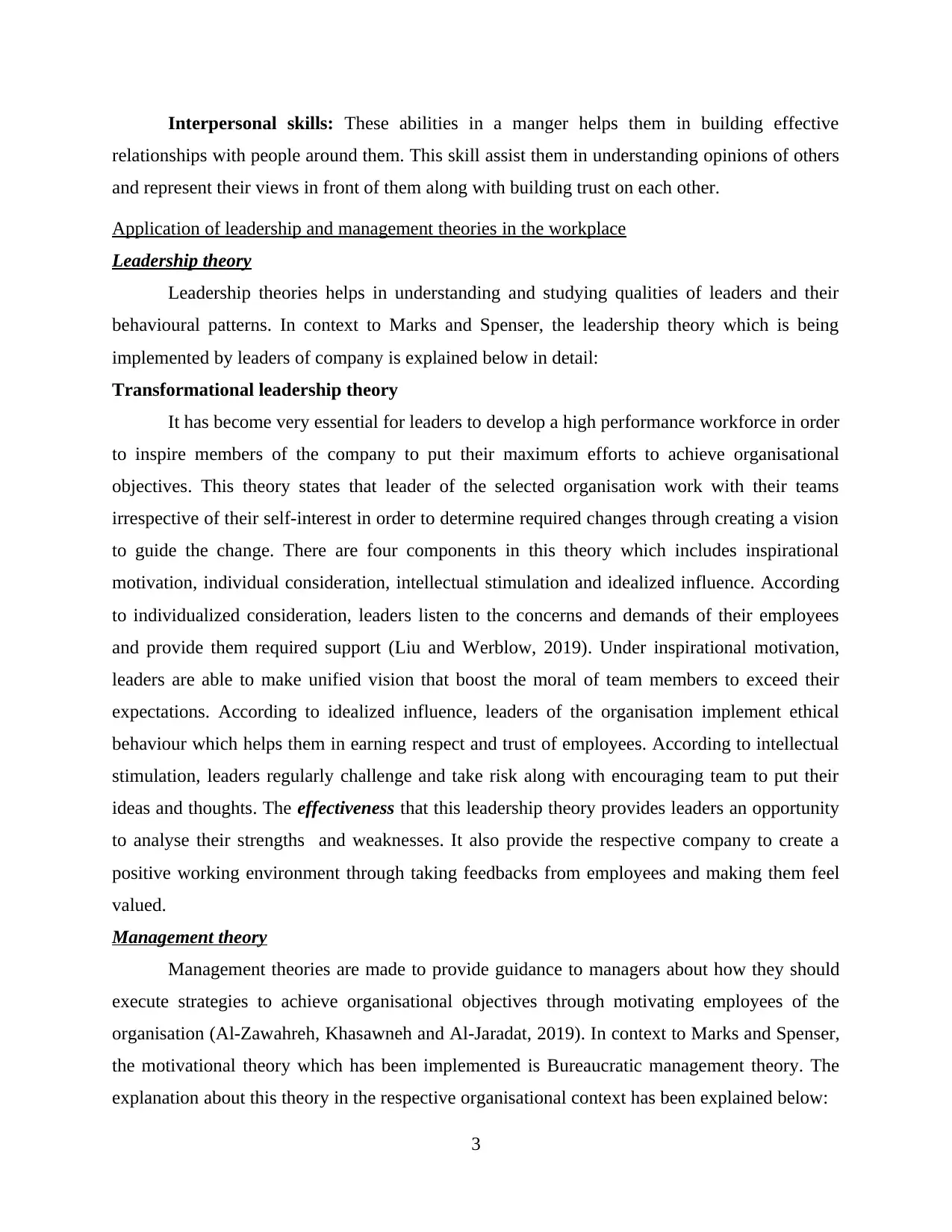
Interpersonal skills: These abilities in a manger helps them in building effective
relationships with people around them. This skill assist them in understanding opinions of others
and represent their views in front of them along with building trust on each other.
Application of leadership and management theories in the workplace
Leadership theory
Leadership theories helps in understanding and studying qualities of leaders and their
behavioural patterns. In context to Marks and Spenser, the leadership theory which is being
implemented by leaders of company is explained below in detail:
Transformational leadership theory
It has become very essential for leaders to develop a high performance workforce in order
to inspire members of the company to put their maximum efforts to achieve organisational
objectives. This theory states that leader of the selected organisation work with their teams
irrespective of their self-interest in order to determine required changes through creating a vision
to guide the change. There are four components in this theory which includes inspirational
motivation, individual consideration, intellectual stimulation and idealized influence. According
to individualized consideration, leaders listen to the concerns and demands of their employees
and provide them required support (Liu and Werblow, 2019). Under inspirational motivation,
leaders are able to make unified vision that boost the moral of team members to exceed their
expectations. According to idealized influence, leaders of the organisation implement ethical
behaviour which helps them in earning respect and trust of employees. According to intellectual
stimulation, leaders regularly challenge and take risk along with encouraging team to put their
ideas and thoughts. The effectiveness that this leadership theory provides leaders an opportunity
to analyse their strengths and weaknesses. It also provide the respective company to create a
positive working environment through taking feedbacks from employees and making them feel
valued.
Management theory
Management theories are made to provide guidance to managers about how they should
execute strategies to achieve organisational objectives through motivating employees of the
organisation (Al-Zawahreh, Khasawneh and Al-Jaradat, 2019). In context to Marks and Spenser,
the motivational theory which has been implemented is Bureaucratic management theory. The
explanation about this theory in the respective organisational context has been explained below:
3
relationships with people around them. This skill assist them in understanding opinions of others
and represent their views in front of them along with building trust on each other.
Application of leadership and management theories in the workplace
Leadership theory
Leadership theories helps in understanding and studying qualities of leaders and their
behavioural patterns. In context to Marks and Spenser, the leadership theory which is being
implemented by leaders of company is explained below in detail:
Transformational leadership theory
It has become very essential for leaders to develop a high performance workforce in order
to inspire members of the company to put their maximum efforts to achieve organisational
objectives. This theory states that leader of the selected organisation work with their teams
irrespective of their self-interest in order to determine required changes through creating a vision
to guide the change. There are four components in this theory which includes inspirational
motivation, individual consideration, intellectual stimulation and idealized influence. According
to individualized consideration, leaders listen to the concerns and demands of their employees
and provide them required support (Liu and Werblow, 2019). Under inspirational motivation,
leaders are able to make unified vision that boost the moral of team members to exceed their
expectations. According to idealized influence, leaders of the organisation implement ethical
behaviour which helps them in earning respect and trust of employees. According to intellectual
stimulation, leaders regularly challenge and take risk along with encouraging team to put their
ideas and thoughts. The effectiveness that this leadership theory provides leaders an opportunity
to analyse their strengths and weaknesses. It also provide the respective company to create a
positive working environment through taking feedbacks from employees and making them feel
valued.
Management theory
Management theories are made to provide guidance to managers about how they should
execute strategies to achieve organisational objectives through motivating employees of the
organisation (Al-Zawahreh, Khasawneh and Al-Jaradat, 2019). In context to Marks and Spenser,
the motivational theory which has been implemented is Bureaucratic management theory. The
explanation about this theory in the respective organisational context has been explained below:
3
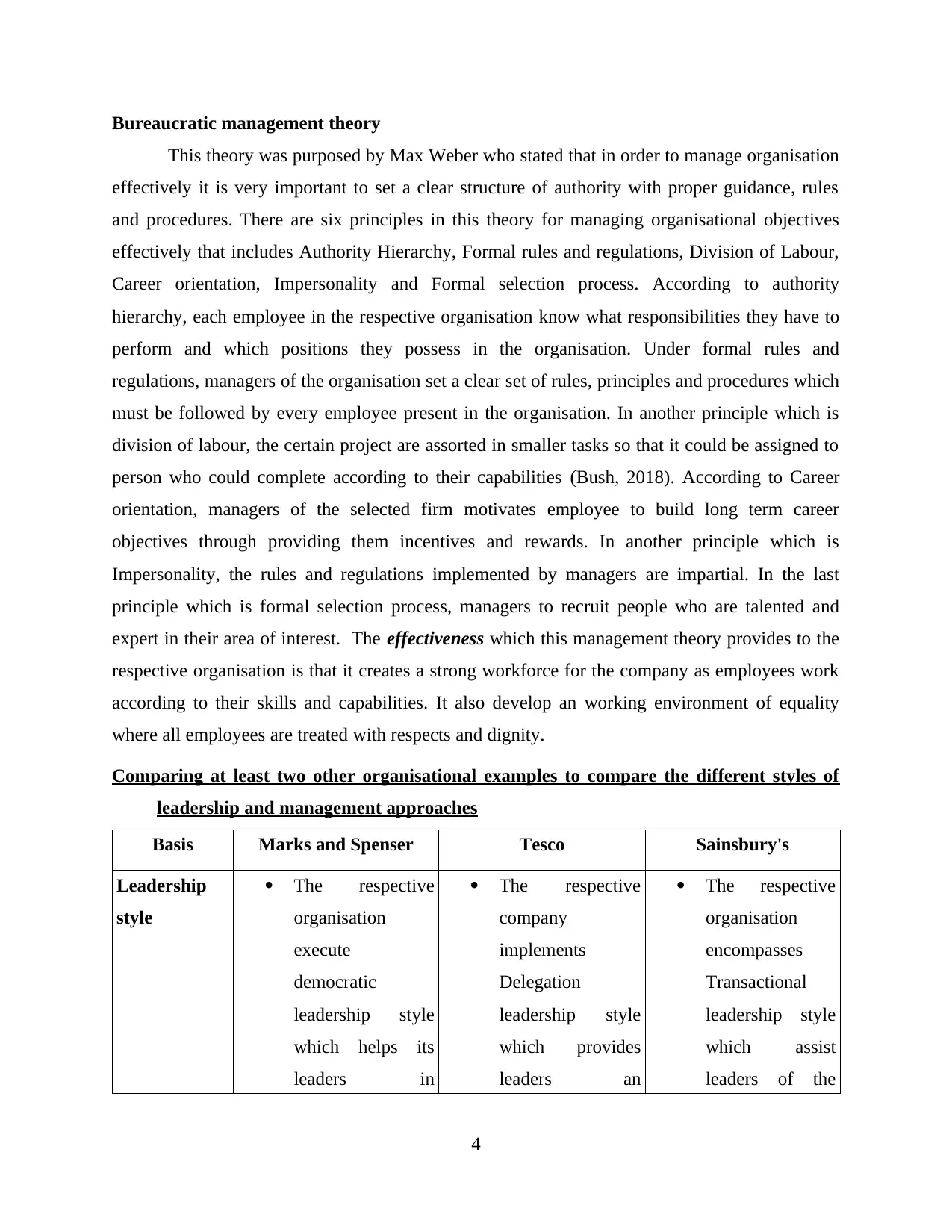
Bureaucratic management theory
This theory was purposed by Max Weber who stated that in order to manage organisation
effectively it is very important to set a clear structure of authority with proper guidance, rules
and procedures. There are six principles in this theory for managing organisational objectives
effectively that includes Authority Hierarchy, Formal rules and regulations, Division of Labour,
Career orientation, Impersonality and Formal selection process. According to authority
hierarchy, each employee in the respective organisation know what responsibilities they have to
perform and which positions they possess in the organisation. Under formal rules and
regulations, managers of the organisation set a clear set of rules, principles and procedures which
must be followed by every employee present in the organisation. In another principle which is
division of labour, the certain project are assorted in smaller tasks so that it could be assigned to
person who could complete according to their capabilities (Bush, 2018). According to Career
orientation, managers of the selected firm motivates employee to build long term career
objectives through providing them incentives and rewards. In another principle which is
Impersonality, the rules and regulations implemented by managers are impartial. In the last
principle which is formal selection process, managers to recruit people who are talented and
expert in their area of interest. The effectiveness which this management theory provides to the
respective organisation is that it creates a strong workforce for the company as employees work
according to their skills and capabilities. It also develop an working environment of equality
where all employees are treated with respects and dignity.
Comparing at least two other organisational examples to compare the different styles of
leadership and management approaches
Basis Marks and Spenser Tesco Sainsbury's
Leadership
style
The respective
organisation
execute
democratic
leadership style
which helps its
leaders in
The respective
company
implements
Delegation
leadership style
which provides
leaders an
The respective
organisation
encompasses
Transactional
leadership style
which assist
leaders of the
4
This theory was purposed by Max Weber who stated that in order to manage organisation
effectively it is very important to set a clear structure of authority with proper guidance, rules
and procedures. There are six principles in this theory for managing organisational objectives
effectively that includes Authority Hierarchy, Formal rules and regulations, Division of Labour,
Career orientation, Impersonality and Formal selection process. According to authority
hierarchy, each employee in the respective organisation know what responsibilities they have to
perform and which positions they possess in the organisation. Under formal rules and
regulations, managers of the organisation set a clear set of rules, principles and procedures which
must be followed by every employee present in the organisation. In another principle which is
division of labour, the certain project are assorted in smaller tasks so that it could be assigned to
person who could complete according to their capabilities (Bush, 2018). According to Career
orientation, managers of the selected firm motivates employee to build long term career
objectives through providing them incentives and rewards. In another principle which is
Impersonality, the rules and regulations implemented by managers are impartial. In the last
principle which is formal selection process, managers to recruit people who are talented and
expert in their area of interest. The effectiveness which this management theory provides to the
respective organisation is that it creates a strong workforce for the company as employees work
according to their skills and capabilities. It also develop an working environment of equality
where all employees are treated with respects and dignity.
Comparing at least two other organisational examples to compare the different styles of
leadership and management approaches
Basis Marks and Spenser Tesco Sainsbury's
Leadership
style
The respective
organisation
execute
democratic
leadership style
which helps its
leaders in
The respective
company
implements
Delegation
leadership style
which provides
leaders an
The respective
organisation
encompasses
Transactional
leadership style
which assist
leaders of the
4
You're viewing a preview
Unlock full access by subscribing today!
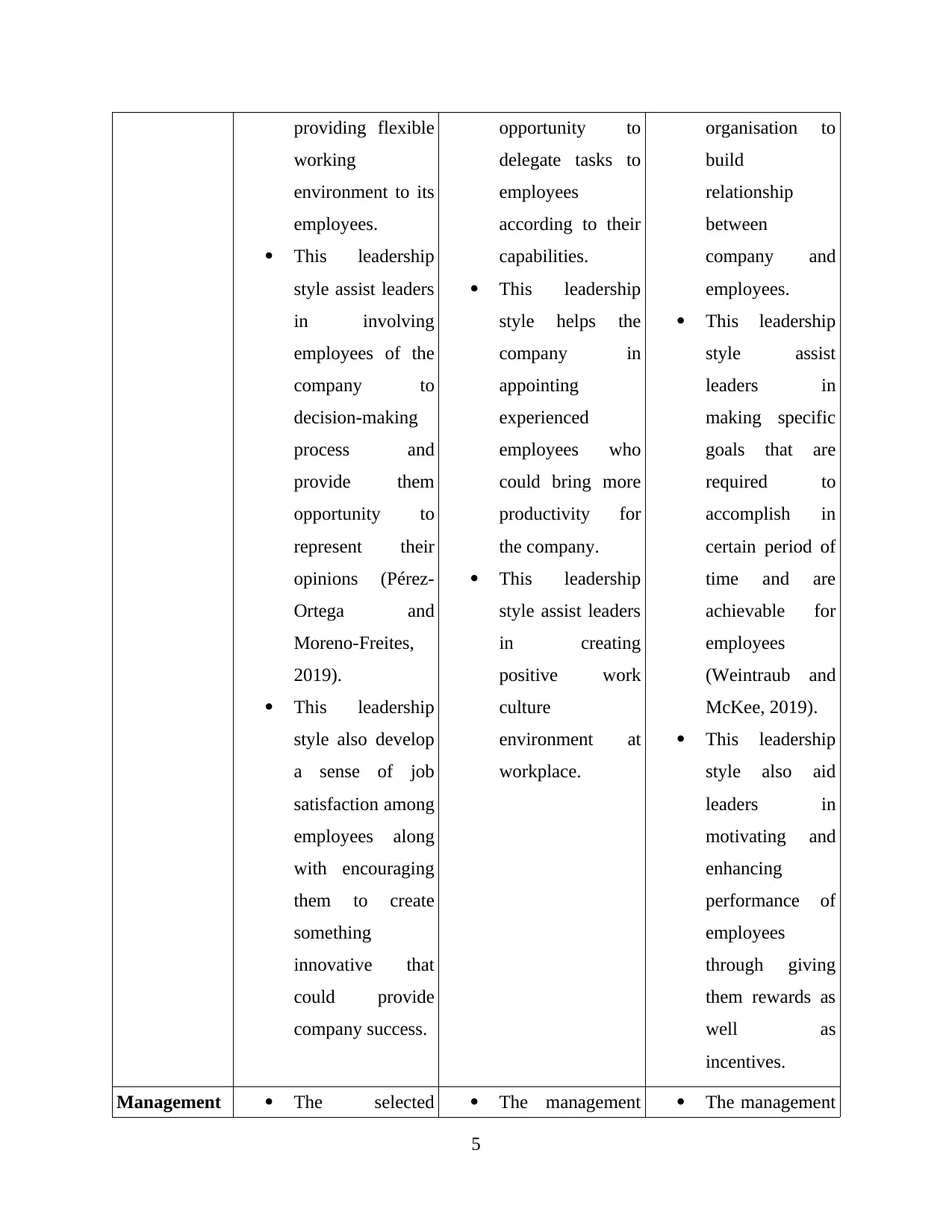
providing flexible
working
environment to its
employees.
This leadership
style assist leaders
in involving
employees of the
company to
decision-making
process and
provide them
opportunity to
represent their
opinions (Pérez-
Ortega and
Moreno-Freites,
2019).
This leadership
style also develop
a sense of job
satisfaction among
employees along
with encouraging
them to create
something
innovative that
could provide
company success.
opportunity to
delegate tasks to
employees
according to their
capabilities.
This leadership
style helps the
company in
appointing
experienced
employees who
could bring more
productivity for
the company.
This leadership
style assist leaders
in creating
positive work
culture
environment at
workplace.
organisation to
build
relationship
between
company and
employees.
This leadership
style assist
leaders in
making specific
goals that are
required to
accomplish in
certain period of
time and are
achievable for
employees
(Weintraub and
McKee, 2019).
This leadership
style also aid
leaders in
motivating and
enhancing
performance of
employees
through giving
them rewards as
well as
incentives.
Management The selected The management The management
5
working
environment to its
employees.
This leadership
style assist leaders
in involving
employees of the
company to
decision-making
process and
provide them
opportunity to
represent their
opinions (Pérez-
Ortega and
Moreno-Freites,
2019).
This leadership
style also develop
a sense of job
satisfaction among
employees along
with encouraging
them to create
something
innovative that
could provide
company success.
opportunity to
delegate tasks to
employees
according to their
capabilities.
This leadership
style helps the
company in
appointing
experienced
employees who
could bring more
productivity for
the company.
This leadership
style assist leaders
in creating
positive work
culture
environment at
workplace.
organisation to
build
relationship
between
company and
employees.
This leadership
style assist
leaders in
making specific
goals that are
required to
accomplish in
certain period of
time and are
achievable for
employees
(Weintraub and
McKee, 2019).
This leadership
style also aid
leaders in
motivating and
enhancing
performance of
employees
through giving
them rewards as
well as
incentives.
Management The selected The management The management
5
Paraphrase This Document
Need a fresh take? Get an instant paraphrase of this document with our AI Paraphraser
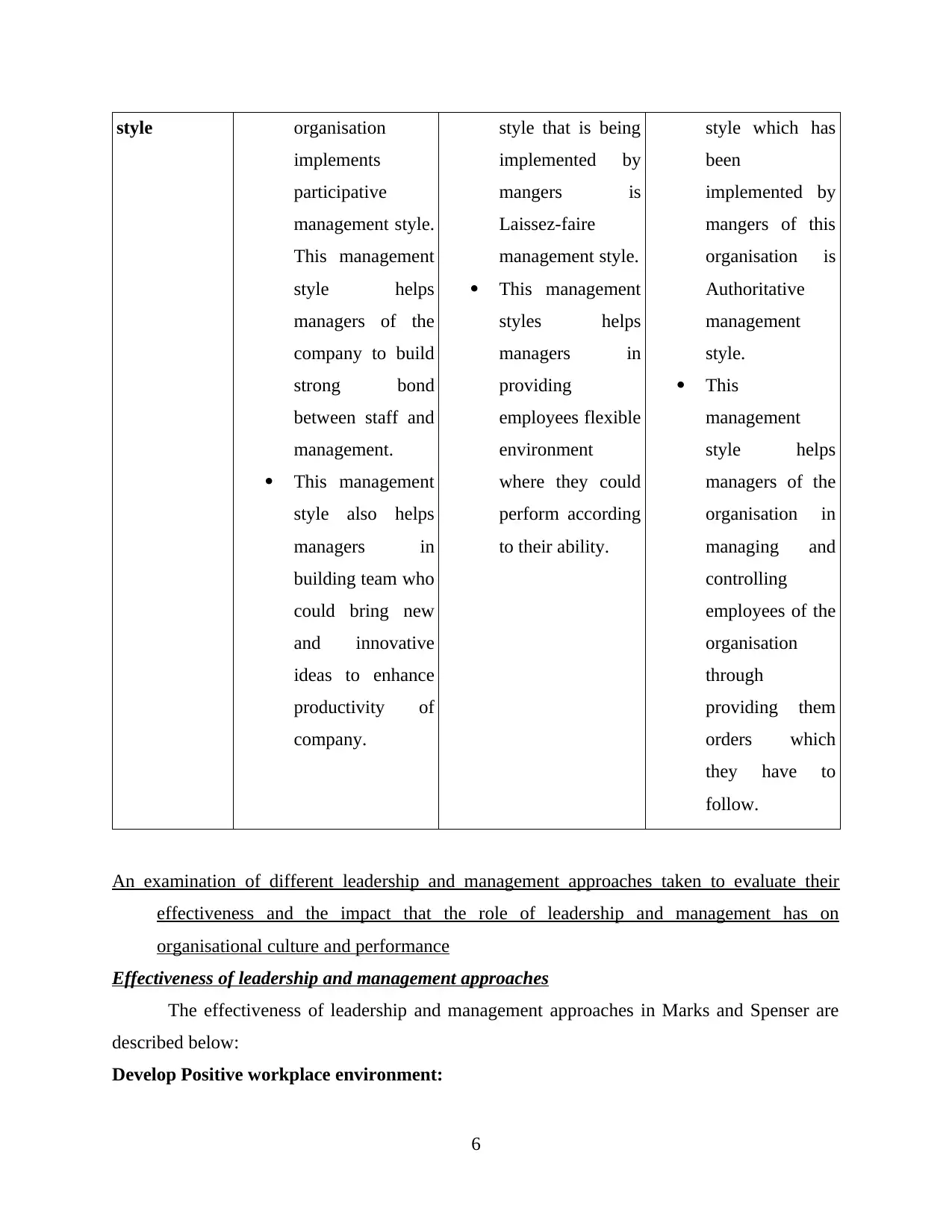
style organisation
implements
participative
management style.
This management
style helps
managers of the
company to build
strong bond
between staff and
management.
This management
style also helps
managers in
building team who
could bring new
and innovative
ideas to enhance
productivity of
company.
style that is being
implemented by
mangers is
Laissez-faire
management style.
This management
styles helps
managers in
providing
employees flexible
environment
where they could
perform according
to their ability.
style which has
been
implemented by
mangers of this
organisation is
Authoritative
management
style.
This
management
style helps
managers of the
organisation in
managing and
controlling
employees of the
organisation
through
providing them
orders which
they have to
follow.
An examination of different leadership and management approaches taken to evaluate their
effectiveness and the impact that the role of leadership and management has on
organisational culture and performance
Effectiveness of leadership and management approaches
The effectiveness of leadership and management approaches in Marks and Spenser are
described below:
Develop Positive workplace environment:
6
implements
participative
management style.
This management
style helps
managers of the
company to build
strong bond
between staff and
management.
This management
style also helps
managers in
building team who
could bring new
and innovative
ideas to enhance
productivity of
company.
style that is being
implemented by
mangers is
Laissez-faire
management style.
This management
styles helps
managers in
providing
employees flexible
environment
where they could
perform according
to their ability.
style which has
been
implemented by
mangers of this
organisation is
Authoritative
management
style.
This
management
style helps
managers of the
organisation in
managing and
controlling
employees of the
organisation
through
providing them
orders which
they have to
follow.
An examination of different leadership and management approaches taken to evaluate their
effectiveness and the impact that the role of leadership and management has on
organisational culture and performance
Effectiveness of leadership and management approaches
The effectiveness of leadership and management approaches in Marks and Spenser are
described below:
Develop Positive workplace environment:
6
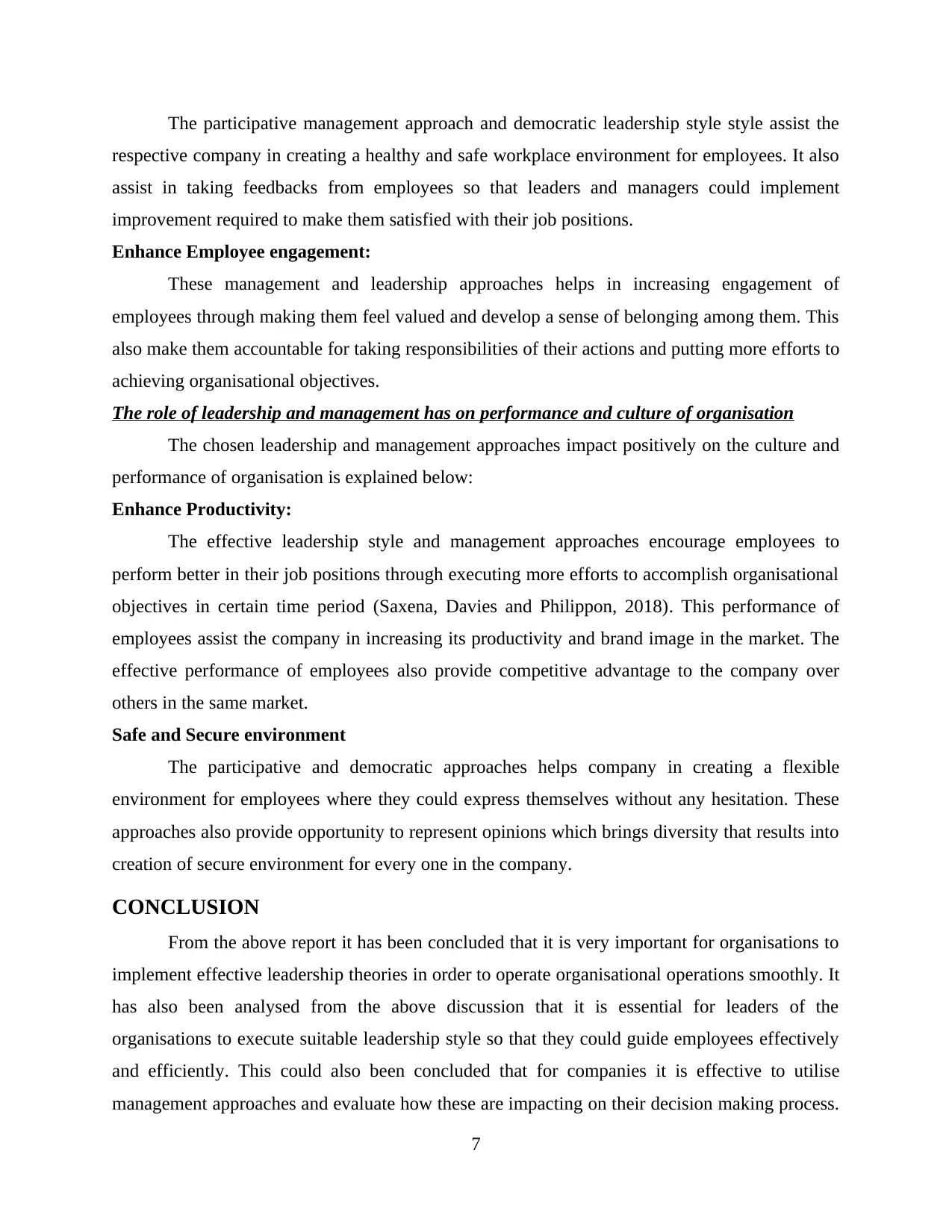
The participative management approach and democratic leadership style style assist the
respective company in creating a healthy and safe workplace environment for employees. It also
assist in taking feedbacks from employees so that leaders and managers could implement
improvement required to make them satisfied with their job positions.
Enhance Employee engagement:
These management and leadership approaches helps in increasing engagement of
employees through making them feel valued and develop a sense of belonging among them. This
also make them accountable for taking responsibilities of their actions and putting more efforts to
achieving organisational objectives.
The role of leadership and management has on performance and culture of organisation
The chosen leadership and management approaches impact positively on the culture and
performance of organisation is explained below:
Enhance Productivity:
The effective leadership style and management approaches encourage employees to
perform better in their job positions through executing more efforts to accomplish organisational
objectives in certain time period (Saxena, Davies and Philippon, 2018). This performance of
employees assist the company in increasing its productivity and brand image in the market. The
effective performance of employees also provide competitive advantage to the company over
others in the same market.
Safe and Secure environment
The participative and democratic approaches helps company in creating a flexible
environment for employees where they could express themselves without any hesitation. These
approaches also provide opportunity to represent opinions which brings diversity that results into
creation of secure environment for every one in the company.
CONCLUSION
From the above report it has been concluded that it is very important for organisations to
implement effective leadership theories in order to operate organisational operations smoothly. It
has also been analysed from the above discussion that it is essential for leaders of the
organisations to execute suitable leadership style so that they could guide employees effectively
and efficiently. This could also been concluded that for companies it is effective to utilise
management approaches and evaluate how these are impacting on their decision making process.
7
respective company in creating a healthy and safe workplace environment for employees. It also
assist in taking feedbacks from employees so that leaders and managers could implement
improvement required to make them satisfied with their job positions.
Enhance Employee engagement:
These management and leadership approaches helps in increasing engagement of
employees through making them feel valued and develop a sense of belonging among them. This
also make them accountable for taking responsibilities of their actions and putting more efforts to
achieving organisational objectives.
The role of leadership and management has on performance and culture of organisation
The chosen leadership and management approaches impact positively on the culture and
performance of organisation is explained below:
Enhance Productivity:
The effective leadership style and management approaches encourage employees to
perform better in their job positions through executing more efforts to accomplish organisational
objectives in certain time period (Saxena, Davies and Philippon, 2018). This performance of
employees assist the company in increasing its productivity and brand image in the market. The
effective performance of employees also provide competitive advantage to the company over
others in the same market.
Safe and Secure environment
The participative and democratic approaches helps company in creating a flexible
environment for employees where they could express themselves without any hesitation. These
approaches also provide opportunity to represent opinions which brings diversity that results into
creation of secure environment for every one in the company.
CONCLUSION
From the above report it has been concluded that it is very important for organisations to
implement effective leadership theories in order to operate organisational operations smoothly. It
has also been analysed from the above discussion that it is essential for leaders of the
organisations to execute suitable leadership style so that they could guide employees effectively
and efficiently. This could also been concluded that for companies it is effective to utilise
management approaches and evaluate how these are impacting on their decision making process.
7
You're viewing a preview
Unlock full access by subscribing today!
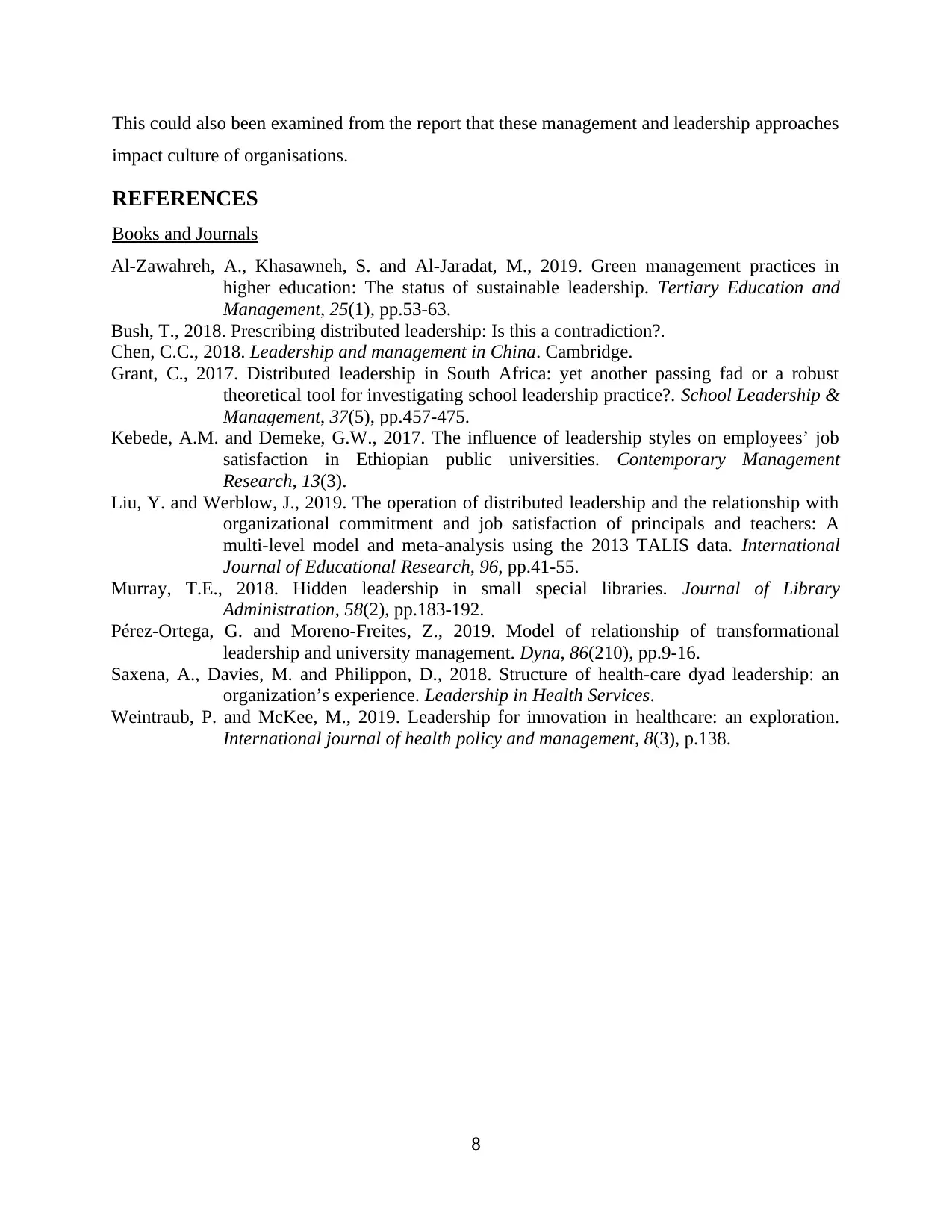
This could also been examined from the report that these management and leadership approaches
impact culture of organisations.
REFERENCES
Books and Journals
Al-Zawahreh, A., Khasawneh, S. and Al-Jaradat, M., 2019. Green management practices in
higher education: The status of sustainable leadership. Tertiary Education and
Management, 25(1), pp.53-63.
Bush, T., 2018. Prescribing distributed leadership: Is this a contradiction?.
Chen, C.C., 2018. Leadership and management in China. Cambridge.
Grant, C., 2017. Distributed leadership in South Africa: yet another passing fad or a robust
theoretical tool for investigating school leadership practice?. School Leadership &
Management, 37(5), pp.457-475.
Kebede, A.M. and Demeke, G.W., 2017. The influence of leadership styles on employees’ job
satisfaction in Ethiopian public universities. Contemporary Management
Research, 13(3).
Liu, Y. and Werblow, J., 2019. The operation of distributed leadership and the relationship with
organizational commitment and job satisfaction of principals and teachers: A
multi-level model and meta-analysis using the 2013 TALIS data. International
Journal of Educational Research, 96, pp.41-55.
Murray, T.E., 2018. Hidden leadership in small special libraries. Journal of Library
Administration, 58(2), pp.183-192.
Pérez-Ortega, G. and Moreno-Freites, Z., 2019. Model of relationship of transformational
leadership and university management. Dyna, 86(210), pp.9-16.
Saxena, A., Davies, M. and Philippon, D., 2018. Structure of health-care dyad leadership: an
organization’s experience. Leadership in Health Services.
Weintraub, P. and McKee, M., 2019. Leadership for innovation in healthcare: an exploration.
International journal of health policy and management, 8(3), p.138.
8
impact culture of organisations.
REFERENCES
Books and Journals
Al-Zawahreh, A., Khasawneh, S. and Al-Jaradat, M., 2019. Green management practices in
higher education: The status of sustainable leadership. Tertiary Education and
Management, 25(1), pp.53-63.
Bush, T., 2018. Prescribing distributed leadership: Is this a contradiction?.
Chen, C.C., 2018. Leadership and management in China. Cambridge.
Grant, C., 2017. Distributed leadership in South Africa: yet another passing fad or a robust
theoretical tool for investigating school leadership practice?. School Leadership &
Management, 37(5), pp.457-475.
Kebede, A.M. and Demeke, G.W., 2017. The influence of leadership styles on employees’ job
satisfaction in Ethiopian public universities. Contemporary Management
Research, 13(3).
Liu, Y. and Werblow, J., 2019. The operation of distributed leadership and the relationship with
organizational commitment and job satisfaction of principals and teachers: A
multi-level model and meta-analysis using the 2013 TALIS data. International
Journal of Educational Research, 96, pp.41-55.
Murray, T.E., 2018. Hidden leadership in small special libraries. Journal of Library
Administration, 58(2), pp.183-192.
Pérez-Ortega, G. and Moreno-Freites, Z., 2019. Model of relationship of transformational
leadership and university management. Dyna, 86(210), pp.9-16.
Saxena, A., Davies, M. and Philippon, D., 2018. Structure of health-care dyad leadership: an
organization’s experience. Leadership in Health Services.
Weintraub, P. and McKee, M., 2019. Leadership for innovation in healthcare: an exploration.
International journal of health policy and management, 8(3), p.138.
8
1 out of 10
Related Documents
Your All-in-One AI-Powered Toolkit for Academic Success.
+13062052269
info@desklib.com
Available 24*7 on WhatsApp / Email
![[object Object]](/_next/static/media/star-bottom.7253800d.svg)
Unlock your academic potential
© 2024 | Zucol Services PVT LTD | All rights reserved.

